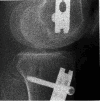Excision of Intra-articular Knee Heterotopic Ossification Using a 70° Arthroscope
- PMID: 38962285
- PMCID: PMC11221981
- DOI: 10.1155/2024/9998388
Excision of Intra-articular Knee Heterotopic Ossification Using a 70° Arthroscope
Abstract
Heterotopic ossification is ectopic lamellar bone formation within soft tissue and can result in significant functional limitations. There are multiple underlying etiologies of HO including musculoskeletal trauma and traumatic brain injury. Intra-articular HO of the knee is rare and is typically located within the cruciate ligaments. We report a case of a 24-year-old female who presented with worsening right knee pain and limited knee extension two and a half years after a motor vehicle crash with multiple lower extremity fractures. Physical examination of the knee revealed anterior pain, limited extension, and a palpable infrapatellar prominence. Imaging showed a retropatellar tendon, intra-articular excrescence of bone proximal to the anterior tibial plateau. Diagnostic arthroscopy with a 70° arthroscope identified HO at the proximal anterior tibial plateau, which was excised with a high-speed burr under direct visualization. At the three-month follow-up, the patient remained asymptomatic and returned to sport. Retropatellar tendon, intra-articular anterior knee HO is a rare but debilitating clinical entity that can be successfully and safely managed with excision under direct visualization using a 70° arthroscope.
Copyright © 2024 Alexander J. Hoffer et al.
Conflict of interest statement
The authors declare that there are no financial conflicts or competing interests regarding publication of this article. Dr. Lyons is an Academic Editor for Case Reports in Orthopedics.
Figures







Similar articles
-
Cementless, Cruciate-Retaining Primary Total Knee Arthroplasty Using Conventional Instrumentation: Technical Pearls and Intraoperative Considerations.JBJS Essent Surg Tech. 2024 Sep 13;14(3):e23.00036. doi: 10.2106/JBJS.ST.23.00036. eCollection 2024 Jul-Sep. JBJS Essent Surg Tech. 2024. PMID: 39280965 Free PMC article.
-
Functional outcomes may vary over time after patellar tendon and knee intra-articular heterotopic ossification excision: A case report.Int J Surg Case Rep. 2025 Feb;127:110773. doi: 10.1016/j.ijscr.2024.110773. Epub 2024 Dec 31. Int J Surg Case Rep. 2025. PMID: 39793335 Free PMC article.
-
Heterotopic ossification in the post cruciate ligament of the knee: a case report and literature review.BMC Musculoskelet Disord. 2021 Mar 26;22(1):304. doi: 10.1186/s12891-021-04176-x. BMC Musculoskelet Disord. 2021. PMID: 33771141 Free PMC article. Review.
-
Rectus Femoris Heterotopic Ossification: Combined Arthroscopic and Open Resection With Allograft Reconstruction and Concomitant Treatment of Femoroacetabular Impingement.Video J Sports Med. 2023 Jan 19;3(1):26350254221138859. doi: 10.1177/26350254221138859. eCollection 2023 Jan-Feb. Video J Sports Med. 2023. PMID: 40308549 Free PMC article.
-
Heterotopic ossification in the knee following retrograde nailing of a femur fracture.Eur J Orthop Surg Traumatol. 2023 Oct;33(7):3181-3184. doi: 10.1007/s00590-023-03491-4. Epub 2023 Feb 17. Eur J Orthop Surg Traumatol. 2023. PMID: 36797500 Review.
References
-
- Shehab D., Elgazzar A. H., Collier B. D. Heterotopic ossification. Journal of Nuclear Medicine . 2002;43(3):346–353. - PubMed
Publication types
LinkOut - more resources
Full Text Sources

